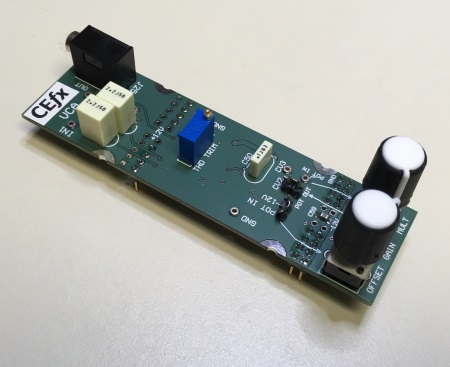

 Loading product data...
Loading product data...

This CEfx VCA module is a low-noise voltage-controlled amplifier based on the THAT 2181. Its control voltage inputs are linear in decibels.
Now turn the OFFSET pot counterclockwise. With no other CV inputs, the OFFSET pot sets the gain to 0dB when fully clockwise, -45dB at 12 o-clock, and -94dB (effectively off) when fully counterclockwise.
Next, turn the MULT pot fully clockwise, check that the jumper between CV2 and POT OUT is installed (just above the MULT pot), and inject an LFO or envelope signal into the POT IN testpoint above the GAIN pot (not the one above the offset pot). Turn the OFFSET pot clockwise until you hear your audio modulated by your control voltage. You might have to adjust the MULT pot to get the right modulation amplitude.
The voltage/gain ratio at the CV inputs is about 24.6dB/Volt, so an envelope or LFO signal of a few volts should be sufficient. If you have larger signals, you can attenuate them with the MULT pot.
There are three summed CV sources: the voltage from the OFFSET pot, the voltage at CV2, which is usually jumpered to the output of the GAIN pot, and a third input, CV3. You can bypass the GAIN pot by removing the jumper connecting CV2 to POT OUT, then drive CV2 directly. At that point, the GAIN pot becomes an uncommitted 50K pot which can be used to attenuate other control voltages in your setup.
If you need to sum three external control voltages, you can remove the jumper connecting "-12V" to "POT IN" just above the offset pot, then send another control voltage into "POT IN". Keep in mind that at least one of your CV sources is going to have to be negative if you want any attenuation.
The ability to sum several control voltages is best done with an inverting summer, so we used the negative control voltage input to the 2181, so that an increase in the control voltage increased the gain. Gain is linear in dB.
Working back from the gain ratio of 6.1 mV/dB at the 2181, the gain is set at U8B to 0.15 to give a ratio of 40.7 mV/dB or 24.6 dB/V. This seemed about the right level of sensitivity, especially considering that some of the control voltages might be coming from 3.3V D/A converters.
We added a CV gain pot to attenuate large envelopes and LFOs, and an offset pot which added a negative voltage in order to turn off the 2181.

